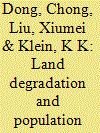| Srl | Item |
| 1 |
ID:
193031


|
|
|
|
|
| Summary/Abstract |
KwaMaye community in KwaZulu-Natal, South Africa, has, for decades, suffered from severe environmental degradation partly due to soil erosion. Yet, no study has analysed farmers’ perception of environmental challenges confronting them and their effects on local livelihoods. Focus group discussions were conducted with KwaMaye farmers selected through purposive and snowball sampling techniques. KwaMaye farmers argued that soil erosion is triggered by climate fluctuations, overgrazing, termites and moles infestation. Also, the farmers suggested that environmental degradation has worsened in recent years due to increasing livestock population and shrinking grazing fields, among others. Also, farmers revealed that while provincial authorities during apartheid installed large-scale terracing to combat soil erosion, KwaMaye residents have not received any assistance from the provincial government. The aggressive nature of environmental degradation in KwaMaye has caused some farmers to quit food production despite a series of Indigenous interventions employed to combat soil erosion-related land degradation.
|
|
|
|
|
|
|
|
|
|
|
|
|
|
|
|
| 2 |
ID:
115238


|
|
|
|
|
| Publication |
2012.
|
| Summary/Abstract |
Overgrazing in the grasslands of Inner Mongolia following market reform in China has led to severe soil degradation and desertification. In an effort to revive the ecological environment in northern pastoral areas, the government of China recently adopted an intervention policy to relocate families from areas where excess grazing pressure was seriously compromising land and the environment. A survey was conducted in three villages to determine how well the relocated families have adapted to their new living conditions and the factors that affect their willingness to stay in the new villages. Regression analysis revealed that the most important factors were age of the head of the household, length of time the family has resided in the new village, proportion of total income that is made up of government payments and level of fixed, durable and current assets.
|
|
|
|
|
|
|
|
|
|
|
|
|
|
|
|
| 3 |
ID:
159771


|
|
|
|
|
| Summary/Abstract |
The ravines found along the Chambal River are among the most severe types of gully erosion found in semi-arid India. This paper estimates the extent and areal expansion of ravines over 40 years in the Lower Chambal Valley and provides a classification scheme to understand ravine characteristics in the region. To examine the implications of ravines on socioeconomic development and livelihoods of the people in the area, a mixed method approach has been followed. A combination of spatial and statistical tests has been run to examine the overall status of land degradation and its impact in the area concerned. Village-level socioeconomic data have been integrated with physical and environmental parameters in a GIS environment, which has been supplemented with findings from a qualitative survey in a few villages of the study region. The results show that there is a positive and significant relationship between indices of natural resources availability and socioeconomic development. A majority of villages within ravines were found to be very poor in development. In this fragile environment, people’s livelihoods are being adversely affected because of land degradation.
|
|
|
|
|
|
|
|
|
|
|
|
|
|
|
|